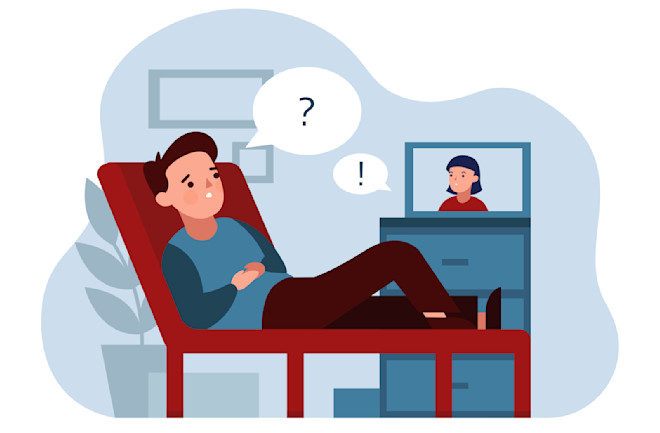When you think of therapy, what comes to mind? Maybe you imagine reclining on a leather chair while a psychologist scribbles on a notepad. Now imagine this: You’re curled up on your own couch in pajamas, perhaps with unbrushed hair, and sharing your problems via text with your virtual therapist.
Apps like BetterHelp and Talkspace make this all possible: You can communicate with their counselors via texts, emails or calls. In fact, the pandemic has made online therapy even more appealing. But with an increased cry for digital help comes the responsibility to provide it with proper mental health care and support. Can virtual therapy prove to be as effective as face-to-face treatment?
Reducing Therapy-Induced Anxiety
Providing mental health care from a distance dates back to the father of psychology himself. (No, Sigmund Freud didn’t text his patients.) But he did use letter-writing to treat his clients. With the current pandemic, however, mental health care from a distance is often a necessity.
Perhaps the biggest concern regarding online therapy is its effectiveness. Despite this, research has deemed online cognitive behavioral therapy to be a worthwhile and practical form of health care. Patients have reported relatively high rates of satisfaction, and they're usually likely to stick with their treatment.
Touting a unique benefit of online therapy, BetterHelp claims that allowing their patients to relax at home while talking to their therapist yields the best therapy results. This is because many people may not feel comfortable opening up in a face-to-face conversation.
Add in a strange new environment to the mixture, and sharing your feelings can prove to be an intimidating experience. For example, it's common to fear being judged by one's therapist. While a well-trained counselor should never make you feel judged, talking to a therapist via text or on the phone may make it easier for to open up. The option of text therapy also allows time to process responses and maintain records of previous conversations.
The demand for therapy has never been higher: Four in 10 U.S. adults have reported symptoms of anxiety or a depressive episode during the pandemic. Between January and June 2019, these numbers were significantly lower with around 1 in 10 people reporting the same symptoms. At a particularly stressful time, online therapy is not only a convenient option, but also a cost-effective one. A study of texting-based psychotherapy revealed that the practice more than halves the cost of traditional services and cuts down wait times.
Virtual therapy may also bring lasting results. To test these outcomes, Swedish researchers recruited 100 participants with a principal anxiety disorder and assigned them to either a treatment or control group. The treatment consisted of weekly exercises that were supervised and guided by online therapists. Afterward, 46 percent of the treatment group had achieved significant improvements, which were maintained during the one-year follow-up.
Limitations to Virtual Therapy
While easy access, convenience and affordability may explain why virtual therapy is taking over, it still poses risks and disadvantages over in-person methods.
For example, psychotherapy often relies on body language as an assessment tool. Virtual counseling, especially text and phone call therapy, erases the opportunity to observe the patient's body language. A 2010 study on nonverbal communication in psychotherapy found that crucial information can be gained from watching a patient's nonverbal behaviors.
Nonverbal signals can often alert a therapist about how comfortable a patient is with a certain topic. This includes behaviors such as eye contact, facial expressions, body postures, gestures and level of concentration, which can hint at hidden feelings or even point toward a specific diagnosis.
For instance, a patient that fidgets, has poor concentration, becomes easily distracted and is unable to remain still may have attention deficit hyperactivity disorder (ADHD). However, these behaviors may not fully translate to a virtual setting. Online therapy also may not be appropriate for individuals in certain situations, including people experiencing psychosis or suicidal intent, during which in-person intervention may be more effective.
And as the pandemic has made clear, technology can hinder virtual conversations. With frozen screens and dropped calls, therapy can grow frustrating without proper equipment and reliable internet connection. Many patients also worry about adequate privacy — that's why finding a reputable online therapist or company is crucial to keep client information safe.
Despite its drawbacks, teletherapy quickly became our new normal. With social distancing guidelines set in place globally this past year, a majority of therapists moved to virtual platforms. While it draws mixed feelings, it's highly likely that we will retain the option of remote therapy for the foreseeable future.

